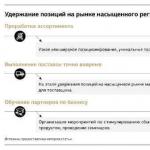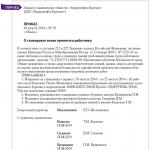Local lighting control must be possible. Local lighting control circuits. Asuno automated outdoor lighting control system
6.5.20. For small ones industrial enterprises And settlements It is allowed to provide for the control of external lighting by switching devices installed on the lighting power lines, provided that maintenance personnel have access to these devices.
6.5.21. Centralized management For outdoor lighting of cities and towns, it is recommended to:
Telemechanical - with a population of more than 50 thousand;
Telemechanical or remote - for a population of 20 to 50 thousand;
Remote - for a population of up to 20 thousand.
6.5.22. With centralized control of external lighting of industrial enterprises, the possibility of local lighting control must be ensured.
6.5.23. Lighting control of open technological installations, open warehouses and other open objects in industrial buildings, the lighting of which is powered from internal lighting networks, it is recommended to produce from these buildings or centrally.
6.5.24. The city's outdoor lighting should be controlled from one central control center. In the largest cities, the territories of which are separated by water, forest or natural terrain barriers, regional control centers may be provided.
Direct telephone communication is required between the central and regional control centers.
6.5.25. To reduce the lighting of city streets and squares at night, it is necessary to provide for the possibility of turning off some of the lamps. In this case, turning off two adjacent lamps is not allowed.
6.5.26. For pedestrian and transport tunnels, separate control of lamps for daytime, evening and night operating modes of tunnels should be provided. For pedestrian tunnels, it is also necessary to ensure local control.
6.5.27. Lighting control of the territories of boarding schools, hotels, hospitals, hospitals, sanatoriums, boarding houses, holiday homes, parks, gardens, stadiums and exhibitions, etc. It is recommended to carry out from the control system of external lighting of the settlement. At the same time, the possibility of local control must be ensured.
When the lighting of these objects is powered from the internal lighting networks of buildings, control of external lighting can be carried out from these buildings.
6.5.28. It is recommended to include control over the light fencing of high-rise structures (masts, chimneys, etc.) from the objects to which these structures belong.
6.5.29. Centralized management of outdoor lighting networks in cities, towns and industrial enterprises should be carried out through the use of switching devices installed in outdoor lighting power points.
It is recommended to control switching devices in outdoor lighting networks of cities and towns, as a rule, by cascading them (sequentially).
In aerial cable networks, it is allowed to include up to 10 power points in one cascade, and in cable networks - up to 15 power points of a street lighting network.
LIGHTING CONTROL. (PUE. CHAPTER 6.5)
Chapter 6.5 Lighting control.
General requirements.
6.5.1. The control of external lighting must be independent of the control of internal lighting.
6.5.2. In cities and towns and industrial enterprises, centralized control of outdoor lighting should be provided (see also clauses 6.5.24, 6.5.27, 6.5.28).
Methods and technical means for centralized control systems of external and internal lighting should be determined by feasibility studies.
6.5.3. When using telemechanics in centralized control systems for external and internal lighting, the requirements of Chapter. 3.3.
6.5.4. Centralized lighting control is recommended:
- - external lighting of industrial enterprises - from the power supply control point of the enterprise, and in its absence - from the place where the maintenance personnel are located;
— external lighting of cities and towns - from the external lighting control point;
- internal lighting - from the room in which the service personnel are located.6.5.5. It is recommended to provide power to centralized control devices for external and internal lighting from two independent sources.
Power supply to decentralized control devices can be carried out from the lines supplying lighting installations.
6.5.6. Centralized control systems for external and internal lighting must provide for automatic switching on of lighting in cases of emergency power failure of the main circuit or control circuit and subsequent restoration of power.
6.5.7. When automatically controlling external and internal lighting, for example, depending on the illumination created by natural light, it must be possible to manually control the lighting without the use of automation.
6.5.8. To control indoor and outdoor lighting, control devices installed in distribution devices ah substations, power distribution points, input distribution devices, group panels.
6.5.9. With centralized control of internal and external lighting, monitoring of the position of switching devices (on, off) installed in the lighting power supply circuit must be provided.
In cascade schemes for centralized control of outdoor lighting, it is recommended to provide for monitoring the on (off) state of switching devices installed in the lighting power supply circuit.
In cascade controlled schemes for centralized control of external lighting (clauses 6.1.8, 6.5.29), no more than two uncontrolled power points are allowed.
Interior lighting control.
6.5.10. When powering building lighting from substations and networks located outside these buildings, a control device must be installed at each input device into the building.
6.5.11. When powering four or more group panels with a number of groups of 6 or more from one line, it is recommended to install a control device at the input to each panel.
6.5.12. In rooms with areas with different conditions natural light and various modes work, separate control of zone lighting should be provided.
6.5.13. Switches for lamps installed in rooms with unfavorable environmental conditions are recommended to be moved to adjacent rooms with better conditions environment.
Light switches for showers and changing rooms attached to them, as well as hot shops in canteens must be installed outside these premises.
6.5.14. In long premises with several entrances visited by service personnel (for example, cable, heating, water tunnels), it is recommended to provide lighting control from each entrance or part of the entrances.
6.5.15. In rooms with four or more work lighting fixtures that do not have safety lighting or evacuation lighting, it is recommended to distribute the fixtures into at least two independently controlled groups.
6.5.16. Security lighting and evacuation lighting can be controlled: directly from the room; from group shields; from distribution points; from input distribution devices; from switchgears of substations; centrally from lighting control points using a centralized control system, while control devices should be accessible only to maintenance personnel.
6.5.17. The control of long-term artificial ultraviolet irradiation installations should be provided independently of the control of general room lighting.
6.5.18. Local lighting luminaires must be controlled by individual switches that are a structural part of the luminaire or located in a stationary part of the electrical wiring. At voltages up to 50 V, plug sockets can be used to control lamps.
Outdoor lighting control.
6.5.19. The outdoor lighting control system must ensure that it turns off within no more than 3 minutes.
6.5.20. For small industrial enterprises and populated areas, it is allowed to provide control of external lighting by switching devices installed on the lighting power lines, provided that maintenance personnel have access to these devices.
6.5.21. Centralized control of outdoor lighting in cities and towns is recommended:
- — telemechanical 50 thousand - with a population of more than
- telemechanical or remote - for a population of 20 to 50 thousand;
- remote - for a population of up to 20 thousand.6.5.22. With centralized control of external lighting of industrial enterprises, the possibility of local lighting control must be ensured.
6.5.23. It is recommended to control the lighting of open technological installations, open warehouses and other open objects in industrial buildings, the lighting of which is powered from internal lighting networks, from these buildings or centrally.
6.5.24. The city's outdoor lighting should be controlled from one central control center. In the largest cities, the territories of which are separated by water, forest or natural terrain barriers, regional control centers may be provided.
Direct telephone communication is required between the central and regional control centers.
6.5.25. To reduce the lighting of city streets and squares at night, it is necessary to provide for the possibility of turning off some of the lamps. In this case, turning off two adjacent lamps is not allowed.
6.5.26. For pedestrian and transport tunnels, separate control of lamps for daytime, evening and night operating modes of tunnels should be provided. For pedestrian tunnels, it is also necessary to ensure local control.
6.5.27. Lighting control of the territories of boarding schools, hotels, hospitals, hospitals, sanatoriums, boarding houses, holiday homes, parks, gardens, stadiums and exhibitions, etc. It is recommended to carry out from the control system of external lighting of the settlement. At the same time, the possibility of local control must be ensured.
When the lighting of these objects is powered from the internal lighting networks of buildings, control of external lighting can be carried out from these buildings.
6.5.28. It is recommended to include control over the light fencing of high-rise structures (masts, chimneys, etc.) from the objects to which these structures belong.
6.5.29. Centralized management of outdoor lighting networks in cities, towns and industrial enterprises should be carried out through the use of switching devices installed in outdoor lighting power points.
It is recommended to control switching devices in outdoor lighting networks of cities and towns, as a rule, by cascading them (sequentially).
In aerial cable networks, it is allowed to include up to 10 power points in one cascade, and in cable networks - up to 15 power points of a street lighting network.
Schemes used in modern projects remote control external lighting (see diagrams below in Fig. 1 - 6) provide:
centralized lighting control from one point separately for each object,
monitoring the position of magnetic starters,
local lighting control of individual objects with overall centralized control,
repair shutdown of external lighting with food station,
the ability to turn off the working lighting of objects in the controlled area from the centralized lighting shutdown console,
partial shutdown of working lighting of a separate row of objects from the control cabinet.
Remote control is carried out by PM magnetic starters installed on the supply lines of outdoor lighting objects. Magnetic starters are controlled from control cabinets automatically using a photo relay of the external lighting control device AO. It is possible to control manually remotely using switches B in the control circuit by selecting the mode using the PU control mode switch.

Rice. 1. Schematic diagram lighting control circuits

Rice. 2. Schematic diagram of lighting control circuits
Centralized shutdown of external lighting is carried out by introducing into the control circuits a block contact of a centralized shutdown relay RO on the centralized shutdown panel or a block contact of a double voltage reduction relay DSN installed in relay cabinets.
The installation location for centralized switch-off of external lighting is determined by the project.
Objects are distributed into groups of emergency and working lighting for each controlled area for a specific design in accordance with current instructions.

Rice. 3. Schematic diagram of lighting control circuits for up to five objects: RP1, RP2 - intermediate relay, LKN - feeder voltage control lamp

Rice. 4. Schematic diagram of lighting control circuits for up to seven objects when placing control equipment for a nuclear power plant or control room at a control point
Networks for remote control of external lighting should be carried out using control cables laid in the ground or suspended on a cable along overhead line supports. Remote control networks are calculated from the condition that for reliable operation of magnetic starters, the voltage loss in the network should not exceed 15% at the moment of switching on.
When used in magnetic starter circuits with high starting currents, as well as at large distances between the external lighting control point and power points, an intermediate relay is introduced into the remote control circuit. In this case, the cable cross-section is selected based on the inrush current of this relay. It is recommended to use complete control devices as power supply cabinets for outdoor lighting: control boxes and control cabinets. Boxes and cabinets for power supply of external lighting are installed in the subscriber part of transformer substations.
Centralization of lighting control is often carried out using cascade schemes, in which sections of the distribution lines of the outdoor lighting network are controlled by connecting the contactor coil of the second section to the line of the first, the contactor coil of the third section to the line of the second, etc. The number of sections should not exceed 10. In this case, a controlled direction of the cascade through sequential inclusion of sections, in which the beginning of the first and the end of the last section of the cascade are brought into the control point and monitoring the state of the cascade.

Rice. 5. Schematic diagram of lighting control circuits for up to seven objects when placing nuclear control or control equipment at substations

Rice. 6. Schematic diagram of lighting control circuits for up to 12 objects when placing control equipment at substations
Remote control of outdoor lighting should be carried out according to the light calendar and the schedule for turning on and off installations for a populated area, according to the operating hours of lighting installations per month for settlements located at different latitudes, which can be used to plan electricity consumption.
Deviations from the schedule for turning on and off installations drawn up for clear weather due to unfavorable weather conditions are allowed for no more than 15 minutes, i.e., a total daily increase in the operating time of installations is 30 minutes (15 minutes in the evening and 15 minutes in the morning).
It is recommended to check the time of switching on or off the installations using photoelectric automatic devices of types, etc., configured for the specified range of illumination, in control rooms.
Photosensors must be installed in accordance with their operating instructions. General requirement is to orient the photo sensor to the north so that direct sunlight does not fall on it during the day. Illumination of the photosensor by extraneous light sources - lamps, spotlights, etc. should also be excluded.
Section 6. Electric lighting
Chapter 6.5. Lighting control
General requirements
Methods and technical means for centralized control systems for external and internal lighting should be determined by feasibility studies.
6.5.3. When using telemechanics in centralized control systems for external and internal lighting, the requirements of Chapter. 3.3.
6.5.4. Centralized lighting control is recommended:
external lighting of industrial enterprises - from the power supply control point of the enterprise, and in its absence - from the place where the maintenance personnel are located;
external lighting of cities and towns - from the external lighting control point;
internal lighting - from the room in which the service personnel are located.
6.5.5. It is recommended to provide power to centralized control devices for external and internal lighting from two independent sources.
6.5.6. Centralized control systems for external and internal lighting must provide for automatic switching on of lighting in cases of emergency power failure of the main circuit or control circuit and subsequent restoration of power.
6.5.7. By doing automatic control external and internal lighting, for example, depending on the illumination created by natural light, it should be possible to manually control the lighting without the use of automation.
6.5.8. To control internal and external lighting, control devices installed in switchgears of substations, power distribution points, input switchgears, and group panels can be used.
6.5.9. With centralized control of internal and external lighting, monitoring of the position of switching devices (on, off) installed in the lighting power supply circuit must be provided.
In cascade schemes for centralized control of outdoor lighting, it is recommended to provide for monitoring the on (off) state of switching devices installed in the lighting power supply circuit.
In cascade controlled schemes for centralized control of external lighting (6.1.8, 6.5.29), no more than two uncontrolled power points are allowed.
Interior lighting control
6.5.10. When powering building lighting from substations and networks located outside these buildings, a control device must be installed at each input device into the building.
6.5.11. When powering four or more group panels with a number of groups of 6 or more from one line, it is recommended to install a control device at the input to each panel.
6.5.12. In rooms with zones with different natural lighting conditions and different operating modes, separate control of zone lighting should be provided.
6.5.13. It is recommended that switches for lamps installed in rooms with unfavorable environmental conditions be moved to adjacent rooms with better environmental conditions.
Light switches for showers and changing rooms attached to them, as well as hot shops in canteens must be installed outside these premises.
6.5.14. In long premises with several entrances visited by service personnel (for example, cable, heating, water tunnels), it is recommended to provide lighting control from each entrance or part of the entrances.
6.5.15. In rooms with four or more work lighting fixtures that do not have safety lighting or evacuation lighting, it is recommended to distribute the fixtures into at least two independently controlled groups.
6.5.16. Security lighting and evacuation lighting can be controlled: directly from the room; from group shields; from distribution points; from input distribution devices; from switchgears of substations; centrally from lighting control points using a centralized control system, while access to control devices should only be possible for maintenance personnel.
6.5.17. The control of long-term artificial ultraviolet irradiation installations should be provided independently of the control of general room lighting.
6.5.18. Local lighting luminaires must be controlled by individual switches that are a structural part of the luminaire or located in a stationary part of the electrical wiring. At voltages up to 50 V, plug sockets can be used to control lamps.
Outdoor lighting control
6.5.19. The outdoor lighting control system must ensure that it turns off within no more than 3 minutes.
6.5.20. For small industrial enterprises and populated areas, it is allowed to provide control of external lighting by switching devices installed on lighting power lines, subject to access to these devices by maintenance personnel.
6.5.21. Centralized control of outdoor lighting in cities and towns is recommended:
telemechanical - with a population of more than 50 thousand;
telemechanical or remote - with a population of 20 to 50 thousand;
remote - with a population of up to 20 thousand.
6.5.22. With centralized control of external lighting of industrial enterprises, the possibility of local lighting control must be ensured.
6.5.23. It is recommended to control the lighting of open technological installations, open warehouses and other open objects in industrial buildings, the lighting of which is powered from internal lighting networks, from these buildings or centrally.
6.5.24. The city's outdoor lighting should be controlled from one central control center. In the largest cities, the territories of which are separated by water, forest or natural terrain barriers, regional control centers may be provided.
There must be direct telephone communication between the central and regional control centers.
6.5.25. To reduce the illumination of city streets and squares at night, it is allowed to provide for the possibility of turning off some of the lamps. In this case, turning off two adjacent lamps is not allowed.
6.5.26. For pedestrian and transport tunnels, separate control of lamps for daytime, evening and night operation of tunnels should be provided. For pedestrian tunnels, in addition, the possibility of local control must be ensured.
6.5.27. It is recommended to control the lighting of the territories of boarding schools, hotels, hospitals, hospitals, sanatoriums, boarding houses, holiday homes, parks, gardens, stadiums and exhibitions, etc. from the external lighting control system of the populated area. At the same time, the possibility of local control must be ensured.
When the lighting of these objects is powered from the internal lighting networks of buildings, control of external lighting can be carried out from these buildings.
6.5.28. It is recommended to include control over the light fencing of high-rise structures (masts, chimneys, etc.) from the objects to which these structures belong.
6.5.29. Centralized management of outdoor lighting networks in cities, towns and industrial enterprises should be carried out through the use of switching devices installed in outdoor lighting power points.
It is recommended to control switching devices in outdoor lighting networks of cities and towns, as a rule, by cascading them (sequentially).
In aerial cable networks, it is allowed to include up to 10 power points in one cascade, and in cable networks, up to 15 power points of a street lighting network.






